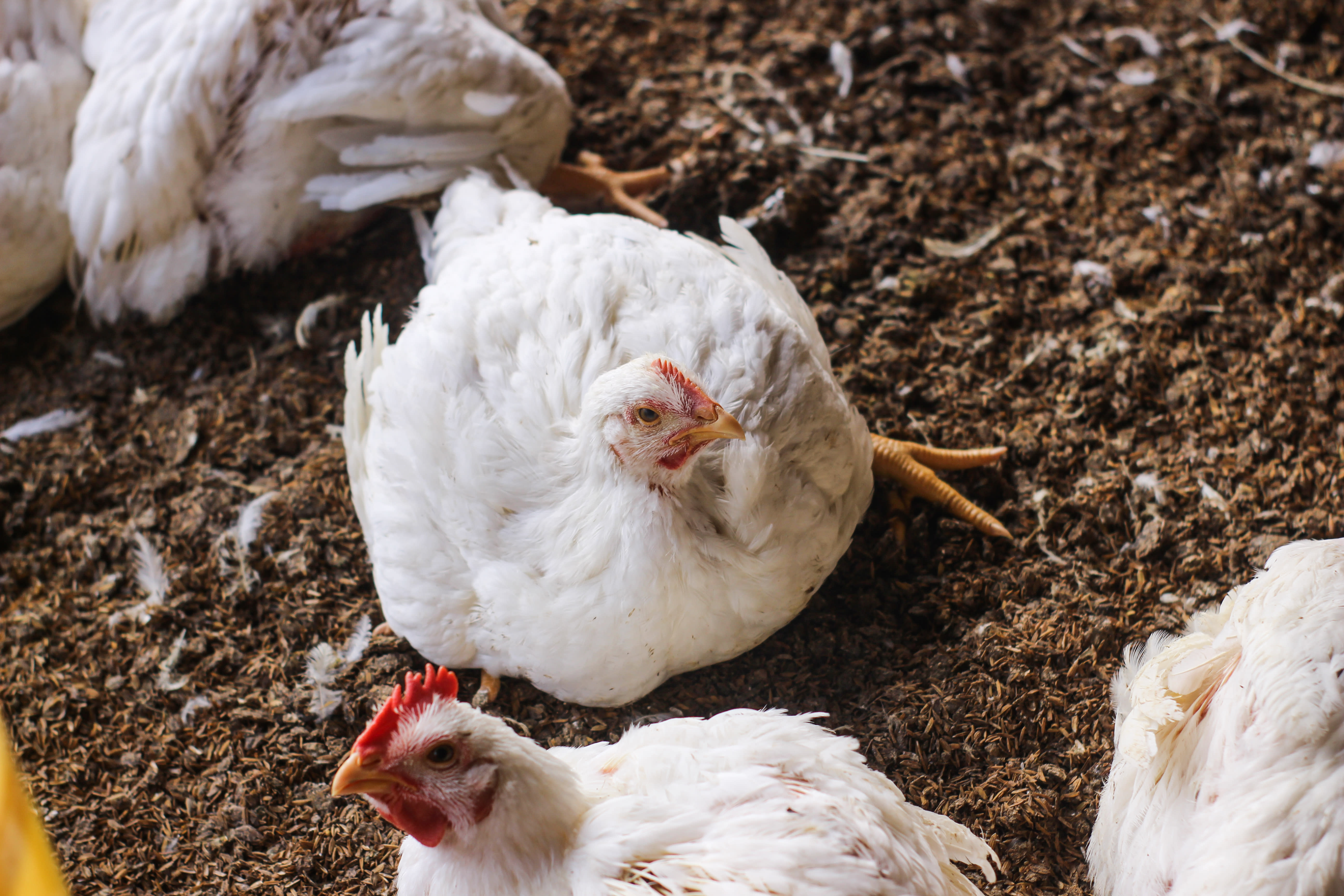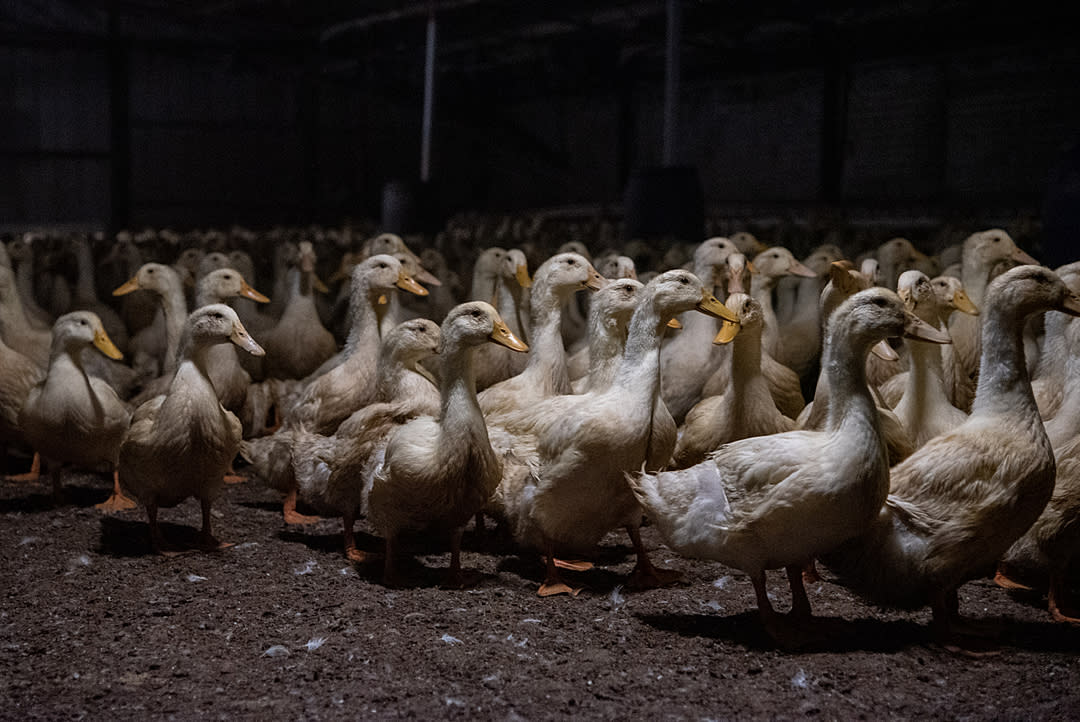




In the United States, the poultry industry kills nine billion chickens every year. These birds live in daily agony, due in part to their rapid growth. Steroids aren’t to blame, however. Their extreme growth is the result of selective breeding—and greed.

Chickens don’t take steroids or hormones. Because they can’t. The Food and Drug Administration actually prohibits the use of these growth enhancers in the billions of chickens—also known as “broilers”—who are raised for meat each year in the US.
Still, most people think otherwise. A 2015 survey by the National Chicken Council revealed that 77% of US consumers believe that farms do use steroids. After all, factory farmed chickens grow way faster and bigger than they did just 50 years ago. What consumers might not know is that the poultry industry—motivated by profit—almost exclusively raises chickens who grow so large that they can’t even walk. And when only the biggest birds breed with the biggest birds, generation after generation, the chickens of today end up looking like they do: unnaturally overgrown.
The life of a chicken raised for meat—what the industry calls a “broiler”—is one of constant agony. By nature, chickens are curious, social, and intelligent animals. But in factory farms, these unique individuals are crowded by the thousands into dark and barren sheds. The nightmarish conditions in these sheds makes life pure misery for chickens—as for any animal. The ground is covered with waste that leaves their delicate skin raw with excruciating ammonia burns, and the putrid fumes infect their eyes and lungs.
And it gets worse. Because a broiler chicken’s body balloons at such a rapid pace, chances are good she won’t be able to support her own weight—or even stand up. The consequences are life-threatening. If she can’t stand, let alone walk, then she can’t make it to the feed and water that’ll sustain her. So she’ll perish right where she is, on the floor of the factory farm.
Why is this the reality for chickens on factory farms? Today’s broilers grow this large, this fast, because the poultry industry wants to produce as much meat as it can—as cheaply as possible. With only financial gain in mind, this industry condemns birds to the debilitating impacts of rapid growth, from leg deformities to heart attacks and even death.
But food retailers are reluctant to share the whole story behind this rapid growth. In the meat aisle at your local grocery store, you’ll find product after product labeled “steroid-free” and “hormone-free.” These labels are true—but only partially. Remember: steroids and hormones aren’t allowed, so all chickens are steroid- and hormone-free. Although chickens aren’t fed artificial growth enhancers, they are selectively bred to get huge—which, too often, entails a great deal of suffering.
What are Chickens Injected with to Make Them Bigger?
The poultry industry boasts that broilers aren’t injected with steroids to artificially increase their growth. And it’s true: they’re not. Chickens don’t get big because of injections. They get that way because, over the course of many years, breeders have forced the largest birds to reproduce with the largest birds, yielding larger and larger chicks. Chickens today are double the size they were 100 years ago, and they get that big in less than half the time.
Labels like “steroid-free” and “hormone-free” sound great, but they’re misleading. It’s nothing special to be steroid- and hormone-free. All broilers are federally required to be free of growth enhancers. No use of steroids or hormones in poultry production has been approved by the Food and Drug Administration. And the US Department of Agriculture requires a disclaimer on poultry products with “hormone-free” labels, which states that “federal regulations prohibit the use of hormones.” But unless consumers know to look closely for these words, they might not realize that hormone-free birds aren’t just the norm but the absolute minimum required by law.
These labels also strongly—and sneakily—suggest that the chickens were raised on factory farms with commitments to animal welfare. But broilers who are steroid- and hormone-free still face extreme suffering. The vast majority of chicken meat in the US comes from factory farms, where birds are forced to grow to a size their bodies often can’t support—all without the use of steroids.
So the problem isn’t steroids. The problem is that these birds are bred to produce as much breast meat as possible, with barely any consideration for their welfare.
Are Hormones or Steroids Added to Chicken?
The FDA banned the use of steroids and hormones in chickens in the 1950s, so today’s broiler chickens get as large as they do thanks to selective breeding—not thanks to growth enhancements.
Over the course of many decades, the US poultry industry has bred larger and larger birds, who reach “market weight” at a younger and younger age. Today, broiler chickens are generally slaughtered at only 47 days old, their natural lifespan of several years drastically shortened.
Even without hormones or steroids, broilers endure excruciating growth, sometimes causing their bones to bow and warp beneath the weight of their own bodies. The poultry industry selectively breeds chickens to maximize its profits—which also, by the same token, maximizes the suffering of billions of birds.
In fact, the greed of the chicken industry is so extreme that it refuses to use steroids and hormones—not because it cares about the health of its birds, but because these enhancements are simply too expensive. The cost is prohibitive, especially given that chickens already grow at a rapid rate without steroids and hormones. The University of Arkansas Division of Agriculture confirms that this practice would likely be too costly and impractical for the industry to keep up. Growth hormones and steroids would need to be injected into every single chicken “almost daily.” It wouldn’t work to add them as a supplement to the broilers’ feed, because they’d be destroyed in the stomach. And, on top of the cost of the hormones and steroids themselves, these enhancements would require intensive labor and time: no-nos in an industry that doesn’t want to slow down.
The Effects of Steroids and Genetic Modification on Chickens
So, chickens don’t endure explosive growth because of steroids and hormones, which federal regulations prohibit. Instead, they’ve been selectively bred to grow as large as they do over multiple generations, the biggest broilers forced to mate with the biggest broilers. But is selective breeding the same thing as genetic modification?
In short, no. People sometimes use the term “genetic modification” to talk about broiler chickens, but it isn’t accurate. Genetic modification refers to the scientific practice of editing DNA in a laboratory setting. This isn’t the case for broilers. They weren’t engineered in labs to grow big and fast. Broilers balloon so intensely thanks to selective breeding, which is a much slower process.
Selective breeding is the practice of breeding two animals with a desired trait in order to produce offspring with that same trait. In the case of broiler chickens, the poultry industry breeds birds who’ll develop outsized breast muscles in as little time as possible. Something called “feed conversion rate”—the ratio between the amount of feed a chicken eats and the amount of body weight she gains—is just one of the traits breeders try to optimize. In this respect, selective breeding has been extremely successful—to the satisfaction of the chicken industry, but to the detriment of chickens.
Such rapid growth can have tragic consequences for broilers. Research shows that broiler chickens are bred to suffer: a 2020 study conducted by the University of Guelph revealed that fast-growing chickens develop bone deformities and muscle diseases, and they often have difficulty walking or even just standing. Many develop common diseases like white striping, which usually shows up in the breast muscles as distinctive white stripes of fat and collagen.
Is Chicken High-Hormone?
In line with federal law, broilers don’t receive synthetic hormones or steroids. But all animals—humans included—have naturally-occurring hormones like estrogen, progesterone and testosterone in their bodies. This means there are hormones in chicken products, too.
Some scientists have connected the hormones found in animal meat to cancer. In 2010, researchers in Japan found high levels of estrogen in US chicken meat and other meat products. Their study warns: “When considering lifetime exposure to meat containing a higher level of estrogen than human fat tissue, estrogen intake from daily meat consumption cannot be disregarded as a factor governing human health.” The research concludes that dietary intake of estrogen from meat could lead to the accumulation of estrogen in the human body and, as a result, “could be related to the incidence of hormone-dependent cancers.”
Effects of Chicken Hormones on Humans
Even though chicken is a major part of American diets, we don’t know a lot about how the naturally-occurring hormones in chicken meat impact human health.
But the link between cancer and the natural hormones found in animal products, notably estrogen, is significant—and it raises serious concerns. A 2016 study by scientists in Mexico concluded that the “intake of a Western diet, particularly of chicken eggs and meat, increases serum concentrations of free estradiol; these results have implications for breast cancer prevention.”
While the poultry industry steers clear of synthetic steroids and hormones, it does add antibiotics to chicken feed—which has consequences for public health. In 1999, the Centers for Disease Control attributed more than half of the world’s antibiotic use to supplements in animal feed, which made bacteria dangerously resilient against the life-saving drugs used to treat human illnesses. Additionally, as researchers in Korea have shown, such rampant antibiotic use could harm people’s gut health.
What You Can Do
Day in and day out, chickens are suffering behind the closed doors of filthy factory farms. Because they’ve been bred to grow to such an extreme size, many of these chickens can’t even support their own body weight and stand up.
But compassionate people around the country are taking a stand for these birds right now by calling on the poultry industry to end its cruelty. Together, we can put a stop to this abuse. Billions of birds are counting on us.





